2022 Triumph Speed Triple 1200 RR - First Ride

A truly modern cafe racer
In Triumph’s modern classic line it has the Thruxton, a contemporary interpretation of the classic cafe racer that mimics styling from the golden era of when those machines were quite literally raced from cafe to cafe in search of “the ton.” For 2020, the British manufacturer took that machine a step further with the Thruxton RS, sprinkling on top-shelf components to give the “modern classic” modern performance.
2022 Triumph Speed Triple 1200 RS Review – First Ride
Now, for 2022, Triumph has proposed an entirely different view of what a modern “cafe racer” can be. Heavily based on the all-new Speed Triple 1200 RS, the RR delivers performance in a more sport-focused package that Triumph says it built to be the “ultimate sports bike for the road.”
2022 Triumph Speed Triple 1200 RR
Editor Score: 91.25%
| Engine | 19/20 | Suspension | 14.5/15 | Transmission | 9.5/10 |
| Brakes | 9/10 | Instruments | 4/5 | Ergonomics | 8.5/10 |
| Appearance | 9.5/10 | Desirability | 9.5/10 | Value | 7.75/10 |
+ Highs
- Stellar handling
- Goldilocks motor
- Lots of adjustability
– Sighs
- Sporty ergos are less street-first
- We’ve crested $20k
- One headlight
We touched down in sunny Malaga, Spain, only to then be welcomed into the mountains by gusty wind and ominous clouds that made for dramatic scenery as we climbed in elevation. With rain in the forecast and temps dropping below freezing at the low end, our street ride around Ronda and the track sessions to follow at the Ascari circuit looked to be in jeopardy, but you don’t fly halfway around the world to not ride a new motorcycle. Our ride day started wet but the precip held off, even giving way to sun as we crested the mountain headed toward San Pedro de Alcántara. The track, given the humidity and cloud cover, never quite dried, but was safe enough to spin a few sessions to try to tap into the Speed Triple RR’s performance.
RS to RR
Twasn’t long ago, though longer now than it seems, we reviewed the Triumph Speed Triple 1200 RS. Triumph treated us to a day at the track and even let us have some alone time with its new naked so we could get some street impressions as well as dyno numbers and verified wet weight. We’ll get to that later though. The new RR is essentially the RS save for a few specific alterations that sharpen its focus pointedly toward sport riding.
First up are the obvious styling changes. A single headlight?! Heresy! Blasphemy! Perhaps, but way back in 1994, the Speed Triple – derived from the Daytona sportbike of the time period – did indeed hit the scene with a single big ol halogen lamp. The RR’s nose-down fairing, carbon fiber detailing, and impeccable paint transforms the look of the Speed Triple toward fairing-clad sports bikes while simultaneously keeping an air of class and style distinct to the British marque. In fact, the lines and balance of the design almost look like the RR was always meant to be present – because it was. The two machines were designed simultaneously with Triumph staggering their release.
Gone is the handlebar of the RS, instead swapped for clip-ons that put the rider’s hands about five inches lower and two inches further forward. The footpegs have also been nudged a tad higher and further back into a more sporting position. These changes distribute a 51% weight bias to the front end to give the rider more feedback from that contact patch.
Next up are the fancy golden, nippled Öhlins Smart EC 2.0 suspension components. As if the RS model’s fully-adjustable NIX30 fork and TTX36 shock needed to be outdone, Triumph has fitted the RR with the Swedish electronic suspenders to allow further adjustability and ease of doing so. As seen in our latest Heavyweight Naked Bike shootout, the trend seems to be heading that way with five of the seven contenders equipped with electronic suspension – some using the Öhlins Smart EC 2.0 components specifically (albeit with their own proprietary tuning). The two holdouts? The KTM 1290 Super Duke R which will have it for 2022, and the Speed Triple RS. When asked if the RS may see the same in the future, Triumph could neither confirm nor deny, rather stating that should their market research point them in that direction, they would oblige, as of now, that was not the case.
The Speed Triple RS was dinged for its stiff suspension settings during the street portion of our Heavyweight Naked Bike comparison with the boss noting, “the Speed Triple is a street bike first, the stiff suspension says otherwise. It’s hard to explain how one factor can make such a big difference in riding experience, but it does.” Evans even went further to say, “I don’t think that these issues could be tuned out without new springs and possibly revalving.” Guest tester and former Speed Triple R owner, Mike V echoed the sentiment, “Triumph carried over many excellent traits from the previous version (slim, comfortable ergonomics, respectable fit and finish) however the suspension still feels harsh…” Tough crowd. Might the Öhlins Smart EC 2.0 units have changed the tides of the Speed Triple’s standing in our test? It’s entirely possible.
Wrapping up the differences from the RS are the RR’s sticky buns: Pirelli Supercorsa SP tires. Triumph has also homologated the Pirelli SC3 tire for the RR for those looking to spend more time at the circuit than the mountains.
Rollin’ down the Ronda Road
I’d never been so annoyed knowing that I had a pinlock-equipped visor at home as I held my breath between photo passes so I could see out of my ill-equipped blue iridium visor. Our cool moist morning start from the Ascari Resort was the epitome of pinlock weather. After having a sit on the RR the night before in a conference room it was clear that despite the riding position being much more, ahem, dedicated, it was still not nearly as uncomfortable as a true sport bike. While it is plenty sporty, the riding position didn’t bother me much as we made our way through small towns and up into the mountains. Of course, once we hit the twistier bits, I welcomed it.
The Triumph Speed Triple had already shown itself to be a stellar handling machine whose light weight and flickability stood out among its class. At an expected 438 pounds, the RR is still a svelte machine, even if it gained a couple of elbees. Now, with the new riding position, handling somehow feels even more effortless. A slight push of the bar and a bit o’ body english gives the RR the feeling of nearly telepathic connectivity – or perhaps my new government-mandated microchip linked my thoughts to the RR’s Bluetooth module (equipped as standard).
Given the weather (and the fact that I couldn’t see anything for the first bit of the ride), I actually tried out Rain mode for the first time on a press ride, which stifles the horsepower and vastly reduces throttle response to work in coordination with the preset TC, ABS, and suspension settings to keep the ride smooth and controlled.
Once I could see again as we crested the mountain and were able to push the pace a bit after getting out from behind a slew of cars, Sport was the move. Throttle response was back to what I remembered, nice and responsive, not abrupt in the slightest while still progressing into the power quickly. And we got all of our horses back in the stable. When we ran the RS on the Rottweiler Performance dyno, she sang to the tune of 156.9 hp at 10,500 rpm and 84.9 lb-ft of torque at 8,400 with a power curve that was smooth as Tennessee whiskey or, perhaps, a nicely aged scotch.
The 1160cc Triple is still the peach that I remembered, delivering excellent low and mid-range punch, while not being as brutal as some other bikes in the open-class naked category. The effort given to ride the Speed Triple smoothly is nil. As it was lauded with praise during the Track portion of our big shootout, the sum of the Speed Triple’s parts equals an impressive package overall. Triumph spent a great deal of time engineering lightness to the motor to have less inertia and in turn a freer spinning nature. Specific attention was paid to the valve train with Triumph reducing weight via hollow valve stems and finger followers while using springs with oval wire to take precious mils off of the overall height of the system. Valve overlap was also reduced to bolster mid-range performance.
Before turning around to head back up the road, I dialed in a bit of “stiffness” to the fork and shock as well as two levels of “braking support” in Sport mode. These are the suspension settings that can be adjusted in each ride mode. You can also switch to a “fixed” configuration within ride modes that locks out the semi-active function and allows the rider to adjust rebound and compression by “clicks” through the TFT display. Triumph aimed for the latter, using the Objective Based Tuning Interface (OBTi), to better explain to riders who don’t know and/or don’t care about what rebound and compression have to do with things. And it is easy. I would love to have spent more time running up and down the Ronda road, tweaking suspension settings here and there to discover the differences, but we just didn’t have the time.
Ascari
Back at the Ascari Race Resort, we geared up for a few sessions on the damp (but drying) track to further push into the RR’s potential. In the same way the RR’s ergos helped in the mountains, they helped on the track. Having the extra confidence in the front end thanks to the weight distribution was helpful for a novice track rider like myself on a damp and fairly recently resurfaced track.
Putting the Speed Triple RR into Track mode un-links the front and rear brakes and allows for more slip from both TC and ABS before intervening. Traction control can be disabled but ABS cannot. When I tried to think back to what stood out to me on the track, I was reminded that it truly is the summation of the entire package that makes the Speed Triple great.
The Brembo Stylemas provide excellent stopping power that’s easy to manage at the lever and being able to adjust the span- and ratio-adjustable Brembo MCS master cylinder allows the rider to dial in his or her preferred feel. It was only after getting on a bike after the second group came in (since we were all sharing motorcycles) and not checking the mode that I got myself into trouble by running wide with the ABS setting coming in much earlier than anticipated in Road mode versus Track – the motorcycle reverts to road as standard if it was turned off in Track mode.
The quickshifter – oh the quickshifter. It is one of the best, if not the best, I’ve had the privilege to use. The stacked gearbox itself is solid too, with no slop and delivers positive gear changes every time. Back to that quickshifter though. Developed through Triumph’s involvement in Moto2, the auto-blipping up and down shifter measures lever and shift drum position, speed, lean angle, and braking force to deliver perfectly smooth shifts every time – a feature I felt spoiled with while lapping Ascari.
The stability and lightweight maneuverability of the chassis was also only more apparent at the track. The sport focused ergos helped the motorcycle feel in its element as I navigated wet patches while tying together Ascari’s famous bends. The option to adjust the suspension easily would have been great if I had more time to do so. With my pace and the track conditions, Track mode’s baseline suspension setting was fine.
At a technical track with a couple nice long straights, a motor like the RR’s Triple is near perfection. The smooth torquey power plant could be easily lugged into corners with its low to mid-range power on tap ready to be rolled on at the exit. The Triple can also be revved out to nearly 11,000 rpm, again, making it a fun and easy machine to ride at the track.
The goal
Heading into this test, I couldn’t wrap my head on why Triumph would make the bike that we’ve been reminded so many times by its marketing department is a street bike first, more sport focused. Triumph explained it sees the RR customer as a niche within a niche. The RR is perhaps for a rider who has a supersport bike at home and maybe races it or does track days, and wants that same performance for the street, but in a less aggressive package. Again, the ultimate sports bike for the road was the goal. As someone who isn’t interested in riding sportbikes anywhere other than the track, I can understand the concept.
Given the extra confidence in its handling that the RR delivers while out in the mountains or lapping the track, it certainly has its advantages and the electronic suspension imbues it with versatility; however, wouldn’t that Öhlins Smart EC 2.0 tech make the already versatile RS even moreso?
As we discussed in the beginning of our heavyweight naked bike shootout’s video, we look at this class of naked bike as a machine that we want to be able to do a little bit of everything. We want to be able to commute or bounce around town in relative comfort, maybe do some touring, while still being able to tear up canyon roads and/or do the odd track day. In my opinion, the RR and RS suspension might make more sense if it were swapped between the models. That does, of course, mean the RS’s price point would have to go up though. The RR comes in at $20,950, a $2,450 premium over the RS. Triumph tells us through its own market research, this is what they feel the customer wants, but if research tells them otherwise in the future, perhaps we’ll see a change. As it sits, the Speed Triple 1200 RR does achieve its goal and is the most sport focused iteration yet without going so far as to totally disregard its street-first lineage.
In Gear – Street

Helmet: AGV Corsa (discontinued)
Jacket: REV’IT! Mantis
Gloves: REV’IT! Prime
Jeans: Pando Moto Steel Black
Boots: Alpinestars Faster 3 Rideknit
In Gear – Track

Helmet: AGV Corsa (discontinued)
Leathers: Alpinestars Motegi V3
Gloves: Alpinestars Supertech
Boots: Alpinestars Supertech-R
2022 Triumph Speed Triple 1200 RR Specifications | |
|---|---|
| MSRP | $20,950 |
| Engine Type | Liquid-cooled, 12 valve, DOHC, inline 3-cylinder |
| Capacity | 1160 cc |
| Bore x Stroke | 90.0 mm x 60.8 mm |
| Compression | 13.2:1 |
| Maximum Power | 156.9 hp @ 10,680 rpm (measured from RS) |
| Maximum Torque | 84.9 lb-ft. @ 8,400 rpm (measured from RS) |
| Fuel System | Multipoint sequential electronic fuel injection with electronic throttle control |
| Exhaust | Stainless steel 3 into 1 header system with underslung primary silencer and side mounted secondary silencer |
| Final Drive | X-ring chain |
| Clutch | Wet, multi-plate, slip & assist |
| Gearbox | 6 speed |
| Frame | Aluminum twin spar frame, bolt-on aluminum rear subframe |
| Swingarm | Aluminum, single-sided |
| Front Wheel | Cast aluminum, 17 x 3.50 in |
| Rear Wheel | Cast aluminum, 17 x 6.00 in |
| Front Tire | Metzeler Racetec RR K3 120/70 ZR17 |
| Rear Tire | Metzeler Racetec RR K3 190/55 ZR17 |
| Front Suspension | Öhlins 43 mm fully-adjustable USD fork, 120 mm of travel. Öhlins S-EC 2.0 OBTi system electronic compression/rebound damping |
| Rear Suspension | Öhlins monoshock RSU w/linkage 120 mm rear wheel travel. Öhlins S-EC 2.0 OBTi system electronic compression/rebound damping |
| Front Brakes | Twin 320mm floating discs. Brembo Stylema monobloc calipers, OC-ABS, radial master cylinder with separate reservoir, span & ratio adjustable. |
| Rear Brakes | Single 220mm disc. Brembo twin piston caliper, OC-ABS. Rear master cylinder with separate reservoir. |
| Instruments | Full-color 5″ TFT instruments |
| Length | 82.09 in (2085 mm) |
| Width (Handlebars) | 29.8 in (758 mm) |
| Height Without Mirrors | 44.1 in (1120 mm) |
| Seat Height | 32.7 in (830 mm) |
| Wheelbase | 56.6 in (1439 mm) |
| Rake/Trail | 23.9°/4.1 inches |
| Wet weight | 438.7 lb (claimed) |
| Fuel Tank Capacity | 3.4 Gallons |
| Fuel Consumption | 29.4 mpg (measured on RS) |
| CO2 Figures | 130 g/km |
| Standard | “EURO 5 CO2 emissions and fuel consumption data are measured according to regulation 168/2013/EC. Figures for fuel consumption are derived from specific test conditions and are for comparative purposes only. They may not reflect real driving results.” |
| Service interval | 10,000 miles (16,000km) / 12 months |
We are committed to finding, researching, and recommending the best products. We earn commissions from purchases you make using the retail links in our product reviews. Learn more about how this works.
Become a Motorcycle.com insider. Get the latest motorcycle news first by subscribing to our newsletter here.

Ryan’s time in the motorcycle industry has revolved around sales and marketing prior to landing a gig at Motorcycle.com. An avid motorcyclist, interested in all shapes, sizes, and colors of motorized two-wheeled vehicles, Ryan brings a young, passionate enthusiasm to the digital pages of MO.
More by Ryan Adams



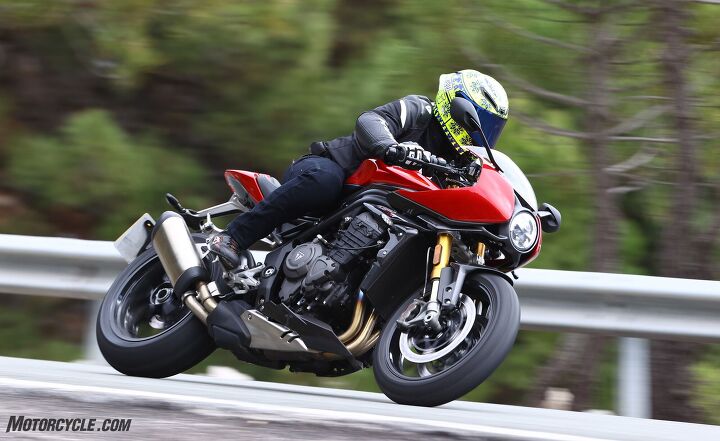
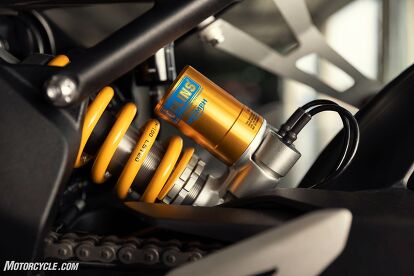






























































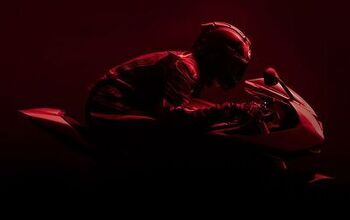
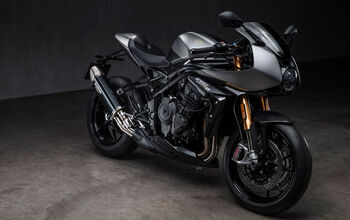
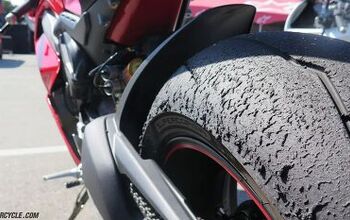













Comments
Join the conversation
Reminds me styling-wise of my old 1984 GPz 750...that half fairing, long and low styling......classic
I have one of these bikes. It's a absolute fun monster for canyon rides. In fact, it's the most fun bike I've ever had and I've had some legends. At 12k miles, it's been flawless. I can't think of a bike I'd trade it for.